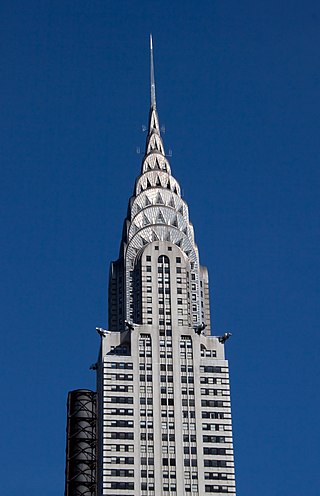
Art Deco, short for the French Arts Décoratifs, and sometimes referred to simply as Deco, is a style of visual arts, architecture, and product design, that first appeared in France in the 1910s, and flourished in the United States and Europe during the 1920s to early 1930s. Through styling and design of the exterior and interior of anything from large structures to small objects, including how people look, Art Deco has influenced bridges, buildings, ships, ocean liners, trains, cars, trucks, buses, furniture, and everyday objects like radios and vacuum cleaners.

Eero Saarinen was a Finnish-American architect and industrial designer who created a wide array of innovative designs for buildings and monuments, including General Motors Technical Center in Warren, Michigan, Dulles International Airport outside Washington, D.C., the TWA Flight Center at John F. Kennedy International Airport, and the Gateway Arch in St. Louis. He was the son of Finnish architect Eliel Saarinen.

Ettore Sottsass was a 20th century Italian architect, noted for also designing furniture, jewellery, glass, lighting, home and office wares, as well as numerous buildings and interiors — often defined by bold colours.

Liberty style was the Italian variant of Art Nouveau, which flourished between about 1890 and 1914. It was also sometimes known as stile floreale, arte nuova, or stile moderno. It took its name from Arthur Lasenby Liberty and the store he founded in 1874 in London, Liberty Department Store, which specialized in importing ornaments, textiles and art objects from Japan and the Far East. Major Italian designers using the style included Ernesto Basile, Ettore De Maria Bergler, Vittorio Ducrot, Carlo Bugatti, Raimondo D'Aronco, Eugenio Quarti, and Galileo Chini.

Florence Marguerite Knoll Bassett was an American architect, interior designer, furniture designer, and entrepreneur who has been credited with revolutionizing office design and bringing modernist design to office interiors. Knoll and her husband, Hans Knoll, built Knoll Associates into a leader in the fields of furniture and interior design. She worked to professionalize the field of interior design, fighting against gendered stereotypes of the decorator. She is known for her open office designs, populated with modernist furniture and organized rationally for the needs of office workers. Her modernist aesthetic was known for clean lines and clear geometries that were humanized with textures, organic shapes, and colour.

Gaetano Pesce is an Italian architect and a design pioneer of the 20th century. Pesce was born in La Spezia in 1939, and he grew up in Padua and Florence. During his 50-year career, Pesce has worked as an architect, urban planner, and industrial designer. His outlook is considered broad and humanistic, and his work is characterized by an inventive use of color and materials, asserting connections between the individual and society, through art, architecture, and design to reappraise mid-twentieth-century modern life.

Charlotte Perriand was a French architect and designer. Her work aimed to create functional living spaces in the belief that better design helps in creating a better society. In her article "L'Art de Vivre" from 1981 she states "The extension of the art of dwelling is the art of living — living in harmony with man's deepest drives and with his adopted or fabricated environment." Charlotte liked to take her time in a space before starting the design process. In Perriand's Autobiography, "Charlotte Perriand: A Life of Creation", she states: "I like being alone when I visit a country or historic site. I like being bathed in its atmosphere, feeling in direct contact with the place without the intrusion of a third party." Her approach to design includes taking in the site and appreciating it for what it is. Perriand felt she connected with any site she was working with or just visiting she enjoyed the living things and would reminisce on a site that was presumed dead.

Wendell Castle was an American sculptor and furniture maker and an important figure in late 20th century American craft. He has been referred to as the "father of the art furniture movement" and included in the "Big 4" of modern woodworking with Wharton Esherick, George Nakashima, and Sam Maloof.

Danish modern is a style of minimalist furniture and housewares from Denmark associated with the Danish design movement. In the 1920s, Kaare Klint embraced the principles of Bauhaus modernism in furniture design, creating clean, pure lines based on an understanding of classical furniture craftsmanship coupled with careful research into materials, proportions, and the requirements of the human body.
Michael McCoy is an American industrial designer and educator who has made significant contributions to American design and design education in the latter half of the 20th century. McCoy is best known as the co-chair of the graduate program in Design at Cranbrook Academy of Art where he and spouse Katherine McCoy pioneered semantic approaches to design.

You Are My Destiny is a South Korean television series television series that aired on KBS1 from May 5, 2008, to January 9, 2009, on Mondays to Fridays at 20:25 for 178 episodes. Starring Im Yoon-ah, Park Jae-jung, Lee Ji-hoon and Gong Hyun-joo, the rating of the drama started at more than 20% in the first episode, and kept increasing. It reached a peak viewership rating of 41.6% in its final episode and was a huge success overall in Korea and many other Asian countries.
Salon 94 was a New York-based contemporary art gallery owned by Jeanne Greenberg Rohatyn.

Joris Hendricus Laarman is a Dutch designer, artist, furniture maker, and entrepreneur best known for his experimental designs inspired by emerging technologies. Laarman's projects are a blend of technology, art and design, with a focus on the potential of 3D printing. Major projects include 3D-printed stainless-steel bridge in Amsterdam, which showcases the potential for creating adaptive, lightweight, and uniquely designed structures using 3D printing. Laarman has also explored furniture design, including the 'Bone' series which used 3D-optimization software to achieve optimal construction. The designer's work often evokes a futuristic feel while nodding to historical art movements, exemplified by pieces like his "Digital Matter" series. When Laarman speaks about his work he discussed the implications and responsibilities that come with breakthrough technologies.
Max Lamb is a British furniture designer who combines traditional, often primitive, design methods with digital design. He is known for employing unusual approaches to using natural materials, including pouring pewter onto sand, and volcanic rock.
Glenn Adamson is an American curator, author, and historian whose research and work focuses on the intersections of design, craft, and contemporary art. Adamson is currently editor-at-large of The Magazine Antiques, editor of Journal of Modern Craft, a freelance writer and a curator. Adamson has held previous notable appointments as the Director of the Museum of Arts and Design, Head of Research at the Victoria and Albert Museum, and as Curator at the Chipstone Foundation.

Cheryl R. Riley is an American artist and furniture designer. Her official website is cherylrriley.com/
Inimfon "Ini" Joshua Archibong is an industrial designer, creative director, artist and musician who is active in product design, furniture design, environmental design, architecture, watch design, and fashion.
Faye Toogood is a British designer based in London. She started her career working as an editor and stylist at The World of Interiors before founding her own studio in 2008. Her work spans furniture, interiors, and fashion.
Najla El Zein is a Lebanese artist and designer.












